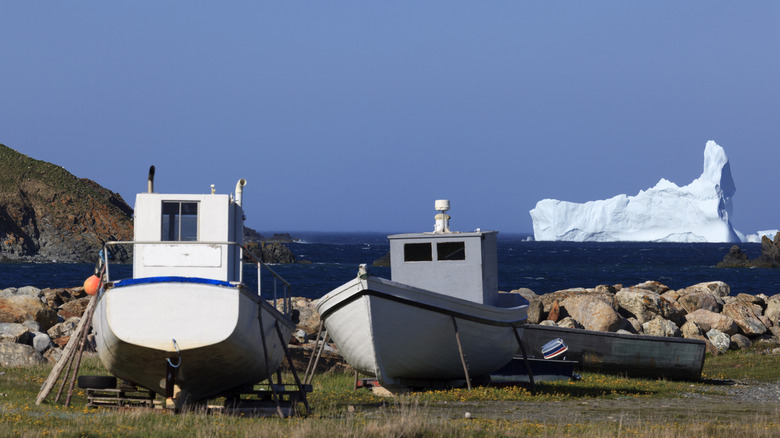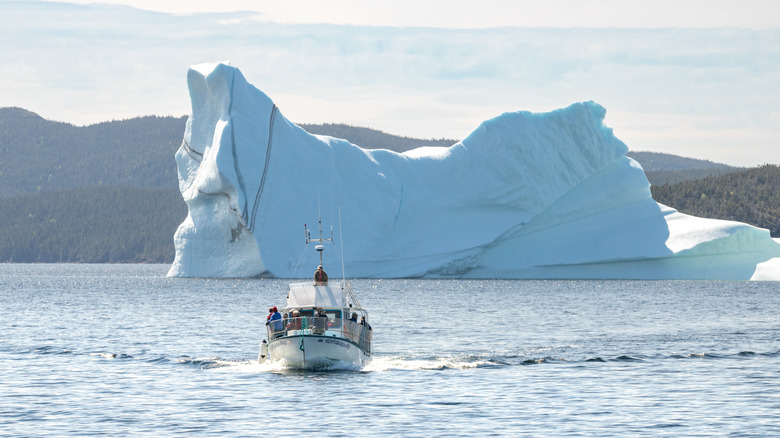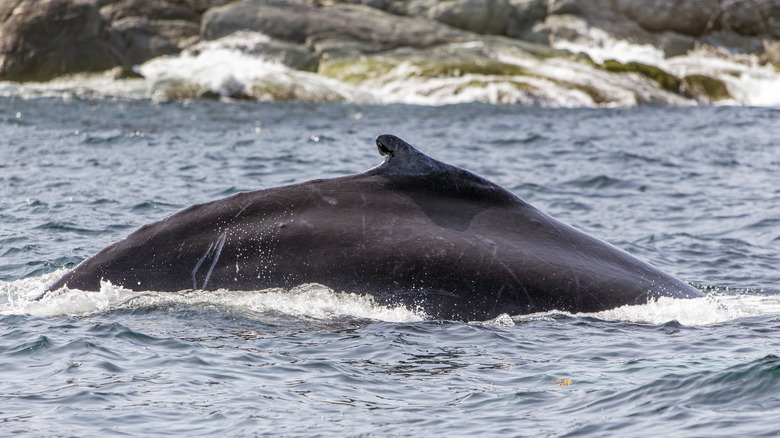The Unique Vacation Destination Where You Can Watch Icebergs Drift Right In Front Of You
Icebergs hold a popular place in our imagination thanks to the sinking of the Titanic, which fatally brushed against a floating mountain of ice in 1912 and foundered with the loss of over 1,500 lives. Such perils at sea aren't just an old-timey phenomenon; in 2007, a cruise ship struck an iceberg and went down off Antarctica. While these vast hunks of ice are most commonly an ocean-faring hazard, there is a place in North America where you can witness their splendor with both feet planted safely on dry land: Iceberg Alley.
Situated off the east coast of the Candian province of Newfoundland and Labrador, Iceberg Alley is an appropriately named stretch of shoreline. Sea currents bring icebergs, mostly calved from the spectacular glaciers of Greenland, on a stately procession within viewing distance of the shore before they gradually melt in warmer southern waters. Viewing these monsters can be an awe-inspiring experience; these icebergs are around 10,000 years old and some are truly gargantuan. In 2010, a vast slab of ice almost the size of Manhattan called Petermann Ice Island-A drifted within 10 miles of the Newfoundland coast.
On average, between 700 and 800 icebergs float along Iceberg Alley each year, making the rugged stretch of shoreline a prime destination for iceberg spotters. If that sounds like your bag, then don't sleep on it: Climate change is causing the Greenland ice sheets to melt faster, and seeing these majestic giants from the land may eventually become a thing of the past.
Where and when to see icebergs in Iceberg Alley
With the number of icebergs visiting Iceberg Alley diminishing, iceberg spotting can be an unpredictable pastime. Some years, the icy beasts linger well into the summer months. but generally speaking the best time is May and June. Even then there is a chance that the 'bergs can get hung up in sea ice further north. Luckily, there are several sources to help iceberg enthusiasts increase their chances of striking it lucky. At Icebergfinder.com, you can sign up for iceberg alerts, and the Newfoundland Iceberg Reports Facebook page is full of the latest sightings.
There are plenty of vantage points to choose from along Newfoundland's north and east coast. The colorful Cape Bonavista Lighthouse is situated on a rocky peninsula with great views across the sea and the nearby Puffin colony; the picturesque town of Twillingate is known as the "iceberg capital of the world;" and the elevated ground of the Brimstone Head Hiking Trail on Fogo Island looks out towards the North Atlantic and the Labrador Sea.
While many of the most spectacular icebergs are easily visible from the shore on a clear day, you may want to get even closer to the action. Iceberg Quest offers boat tours from Twillingate for $95 per adult, with snacks, drinks, a heated cabin to warm up, and "Screech-ins," allowing visitors to become an honorary Newfoundlander by kissing a codfish!
Other things to see and do in Newfoundland and Labrador
Visiting Newfoundland and Labrador is well-suited to people with a love for the great outdoors. Newfoundland itself is the world's 16th largest island and the overall province is bigger than Japan, although it is far less populous with just over half a million inhabitants in total. Iceberg Alley is one of its main tourist attractions, and while you're in the area you will also get other novel ways to engage with the icy behemoths. If you fancy drinking something made from iceberg water, Quidi Vidi Brewery produces lager that boasts being brewed with locally sourced iceberg water. Auk Island Winery in Twillingate offers the unique chance to sip local wines made with iceberg water while (hopefully) watching icebergs float past.
Aside from icebergs, there are plenty of other things to see and do. Whale watching is another popular draw, with the cold waters providing a home for over 20 species including the mighty humpbacks that visit each year. On land, the rugged topography and spectacular coastline are wonderful terrain for hikers who have almost 300 trails to explore. Manmade sights are also worth visiting, including the ancient Viking settlement at L'Anse aux Meadows and the 16th-century Red Bay Basque Whaling Station, both UNESCO World Heritage sites. Bring your warm clothes and a sense of adventure and you'll be rewarded with an unforgettable trip to Newfoundland and Labrador.


